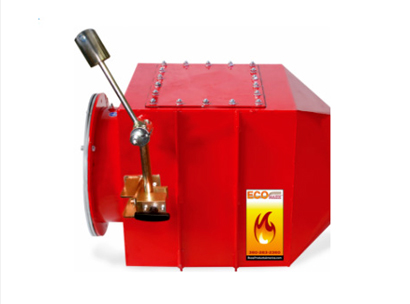Explosion Suppression
Explosion Suppression and Chemical Isolation Systems

IPD Explosion Chemical Suppression and Isolation Systems are designed and manufactured by Industrial Protection Devices, L.L.C. (IPD) for delivery of kosher sodium bicarbonate dry chemical extinguishing agent into developing explosions. The basic control unit for activation of the system is designed to respond to actuation signals from several different types of explosion sensing devices.
The extinguishing agent delivery device or Cannon™ is suitable for use as an explosion suppression unit and/or for chemical isolation purposes.
The extinguishing agent employed is sodium bicarbonate. The agent is stored at atmospheric pressure in a replaceable Canister and is housed in the Cannon™ barrel. The force needed to release the extinguishing agent and propel it into a developing fireball is provided by the combination of an Actuator located in the Canister, and by the release of compressed Nitrogen gas from a pressurized tank.
The Actuator is completely enclosed within each Canister, and performs several functions. The first function of the Actuator is to break up the powder. Second, it provides an accelerating force for the agent as it leaves the Cannon; and third, it simultaneously opens a sealed pressurized tank to release Nitrogen gas. The pressurized Nitrogen adds to the accelerating force of the Actuator, so that extinguishing agent is delivered into the process enclosure with sufficient velocity to reach the developing explosion.
When used for chemical isolation in conjunction with a BS&B Pressure Safety Management (BS&B) explosion vent, a Detector Interface Unit is connected to the BS&B vent switch sensor (Type MBS), and discharge of Isolation Cannons occurs when the vent opens. Alternatively, a separate IPD pressure sensor may be used for activation. In planning an installation of explosion suppression and/or chemical isolation Cannons and associated electronics, it is essential that the user understand and define various safety and operational factors, including the following:
1. Specifications of the dust, gas or vapor that constitutes the potential hazard.
2. Size and geometry of the process enclosure, and of connected equipment.
3. Process operating characteristics such as pressure variations, process temperatures, vibration involved, corrosive or toxic material present, and dry / wet operating conditions.
4. Identification of surface areas available for placement of equipment
5. Arrangements for maintenance operations to be carried out, either through a maintenance contract with IPD or through training of the user’s operating personnel.
6. Designation of operating personnel responsible for attention to fault indications, and for action to remedy any identified faults on a timely basis.
NFPA 69 practices must be followed by the user of this equipment; successful operation of a suppression and/or isolation system is a joint undertaking between the user and the protection equipment supplier. NFPA 69 can be freely viewed and purchased at www.nfpa.org.
